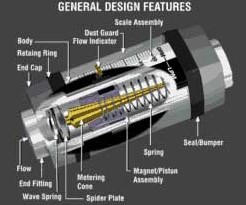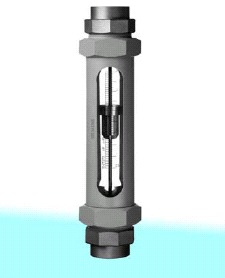Difference between revisions of "Variable Area Meters"
(Created page with "Category:Meters, Gauges{{Knoppen}} <noinclude><!------------------------------------------------ * READ THIS FIRST * Only edit this page if you can improve the content. ...") |
|||
| Line 7: | Line 7: | ||
* Please start editing this page after the /noinclude | * Please start editing this page after the /noinclude | ||
* -------------------------------------------------></noinclude> | * -------------------------------------------------></noinclude> | ||
[[File:Variable area meter.jpg|thumb|right|Variable Area Meters]] | |||
[[File:Variable area meter1.jpg|thumb|right|Variable Area Meters]] | |||
'''Variable Area Meter''' is a meter that measures fluid flow by allowing the cross sectional area of the device to vary in response to the flow, causing some measurable effect that indicates the rate. | |||
The variable area (VA) meters, also commonly called [[Rotameters]], consist of a tapered tube, typically made of glass, with a float inside that is pushed up by fluid flow and pulled down by gravity. As flow rate increases, greater viscous and pressure forces on the float cause it to rise until it becomes stationary at a location in the tube that is wide enough for the forces to balance. Floats are made in many different shapes, with spheres and spherical ellipses being the most common. Some are designed to spin visibly in the fluid stream to aid the user in determining whether the float is stuck or not. Rotameters are available for a wide range of liquids but are most commonly used with water or air. They can be made to reliably measure flow down to 1% accuracy. | |||
Latest revision as of 11:52, 25 December 2012
Variable Area Meter is a meter that measures fluid flow by allowing the cross sectional area of the device to vary in response to the flow, causing some measurable effect that indicates the rate.
The variable area (VA) meters, also commonly called Rotameters, consist of a tapered tube, typically made of glass, with a float inside that is pushed up by fluid flow and pulled down by gravity. As flow rate increases, greater viscous and pressure forces on the float cause it to rise until it becomes stationary at a location in the tube that is wide enough for the forces to balance. Floats are made in many different shapes, with spheres and spherical ellipses being the most common. Some are designed to spin visibly in the fluid stream to aid the user in determining whether the float is stuck or not. Rotameters are available for a wide range of liquids but are most commonly used with water or air. They can be made to reliably measure flow down to 1% accuracy.

